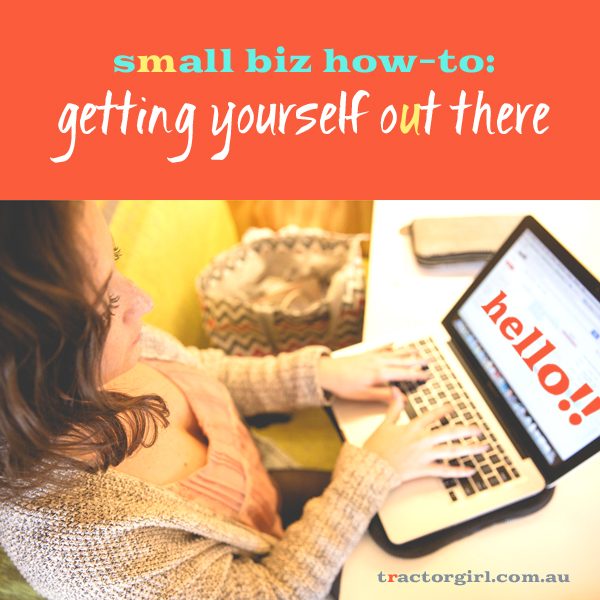Getting yourself out there.
Hiya, and welcome to the THIRD post in a series on ‘Getting Yourself Out There’. It’s been a few months since the last one, but it’s such important info to help you to spread the word about what you do and how that can help others. You can find Part I here (it’s all about using social media like Pinterest and Facebook, and how to keep your customers happy); and Part II here (it’s all about the necessary stuff you should do, like having a business card, blogging, and getting together an email list).
Today’s post is about using other strategies to REALLY get yourself out there! Some of them might seem a bit big and scary, so perhaps not all of them are for introverts…. (but maybe they are – especially after I read what Nathalie Lussier had to say about being an introvert).
So let’s get started.
Guest post
Write articles for other blogs with similar interests to yours. You’ll get a link back to your site at the very least, and at best, it might generate a whole heap of great comments and interest in what you do, and even lead onto other things – a new collaboration? Other guest posting opportunities? Even a paid writing gig?? Truly!
So, the first thing to do is to search around a few blogs that you like and check if they accept guest posts. Then, think of some ideas for guest post topics that would be suitable for that blog. Then contact them and briefly outline your ideas. They’re more likely to respond positively to your emails if you find out the name of the person you’re writing to and use it, and if you write a sentence or two as to what’s good about their blog and why your guest post would be a good fit for it. Most places want to have something that’s written exclusively for them, so before you go ahead and write the whole article, it’s generally better to wait until they’ve said yes (although if you write something and one place says no, you can go ahead and pitch the article to somewhere else that fits with the topic).
An article of around 300 words is a useful size. Just like on your own blog, you can write about anything that suits to focus of the blog – a tutorial, a roundup of information on a particular aspect of what you do, something that inspires you, or even your opinion focusing on issues and/or trends in your industry.
Join a group (or two) in your niche
Do the eyes of your partner/friend/parent/pet dog glaze over when you start talking about your biz? (Or, do they totally proceed to tell you what you’re doing wrong and how they’d run your biz if it was theirs? 🙁 ) Search out some groups of people that are interested in what you are. Search them out – in the phone book, use google, ask your local library, or hang out in a few online forums until you find the ones where you fit. Or even start your own – set up a coffee morning at a local cafe, and advertise it in your local FB groups and on library and community noticeboards.
Other people are awesome! Not only will they ‘get’ you, they will also be able to offer oodles of advice and moral support. A craft group, a small business group, any kind of group that you can chat to about your biz issues, design issues, or whatever it is that concerns you; it all works together to keep you focused and motivated. AND they know other people too – word of mouth is an enormous asset in helping you spread the word.
Run a contest
Once you’ve established yourself a bit on social media, run a giveaway/contest/competition. Offer something of good value that will appeal to your target customer (you’ve already identified who this is, right?). Then ask people to share the contest on their social media as a condition of entry – it’s all about getting your name out there and in front of people’s faces (make full use of hashtags too, they’re fab for tying things together. Best of all is if you can think up an easy-to-remember hashtag that’s exclusive to your comp). As a bonus, you’ll probably end up with a few extra followers/likers on your own social media profiles as well. But it’s generally not helpful to ask them to join as a condition of entry – those folk tend to be temporary ‘likers’ at best and usually disappear again once the comp is over.
Each social media platform has a time frame when they reach their active peak, so think about that when you’re publicising your comp. Tweets last only a few minutes, Facebook posts last an hour or two, Pinterest a bit longer and Instagram around a day or so. Remember also that different types of people prefer different platforms, so use those ones that your ideal customer hangs out on. There’s lots of infographics around on this topic if you’re interested, just google it.
Write a magazine article
It’s the same kind of deal as for when you write a guest post for a blog, except that magazine articles are usually a bit longer. There are some fabulous indie magazines out there who thrive on contributed articles, like Peppermint or ROOOAR Magazine.
And then when you have something published, ask permission to include links/images of the article on your own website, in a section called ‘As Featured In’ or ‘Press’. It adds a lot to your overall professional credibility by demonstrating your work is well received in other places.
Get your work in print
This is for you if you have tangible products – and it’s a little bit different to actually writing a magazine article – it’s more about approaching magazines with images of your work to feature. The advantage of this idea is that you can probably think a bit bigger and go for larger circulation magazines than you would if you’re intending to submit a whole article.
Get clever about your target market. Do your research. Figure out which magazines are closest aligned to your style and target market. For instance, if you’re selling hand-printed teatowels, think of all the home styling magazines that you might like to approach.
Again, do your research – find out the name of the person you should be emailing and use it; BRIEFLY explain who you are and why you think your product would be a good fit for their magazine, and attach 3 or 4 good quality photos of your work.
Youtube yourself
OK, some of us are up for this and some of us aren’t.
BUT YOUR VIDEO DOES NOT HAVE TO BE OF YOU WITH YOUR FACE IN THE CAMERA.
Just like a blog post, it’s a matter of picking a topic. You can do a tutorial, showing only your hands doing the thing that you do. Or, skip the camera altogether and do a PowerPoint video, or a series of photos that tell a story. Beautiful, inspirational and wonderful videos can be made using just images, text and a soundtrack (make sure you have permission to use other people’s images or music if you aren’t creating these yourself).
Again, just pick a topic, and and tell a story about it. Be inventive in your presentation – for instance try arranging household items into words or draw them on chalkboard or use your kid’s toys to get your point across.
I really like this one (except for the plonky music).
And here’s another great example from one of my everyday inspirations, Karen Gunton.
There are some fabulous tutorials on how to make great videos on a budget. I would recommend starting with this beginner’s guide from DesignSponge.
Whatever you do, make sure it fits with your brand.
Above all, your brand is about ‘the mood’ – the personality that you want your business to project out into the world. It’s not just about the service you provide, or the products you supply. It’s about you. People want to deal with YOU because you stand for something. Because you’re consistently providing them with that ‘thing’ that they can only get from you.
If you want be consistent at presenting yourself the same way, every time; if you want to be perceived as reliably providing what your customers are looking for then you MUST have a deep understanding of who and what YOU are, what you stand for, and what you want to put out into the world. You must know who your customer is, and understand what they’re thinking about when they come looking for thing they want, and why they might stop and engage with you.
Once you understand all of that, then it’s a whole lot easier to make sure that every video you record, every article you write, every contest you run – all fits with your brand, and that it’s all building up a distinctive story about you. Everything grows from that base of understanding and reflects your brand in a very authentic way – it’s a combination of your particular visual style, it’s the words you use, it’s how you treat your customers, how you advertise, and much, much more. It’s how you present yourself at every turn.
Each of those touchpoints play their part – however, I would argue that the visuals are the thing you need to get right first. Even though they’re only the surface part of your brand, they’re vital to help you make that initial connection with your audience – because the visuals are the thing that catches your audience’s attention first. Especially in a crowded marketplace. So make sure they’re right. Make sure they’re you.
Need some help with that? You’re welcome to get the free e-book Build Your Brand guidebook here.
If you need more help, you’re welcome to check out my comprehensive e-book on branding too!
*
Have you got any burning questions on how to publicise what you do? Do the above options make you quiver in your shoes?? Let me know in the comments!
Go forth and conquer the world.
Julie X

